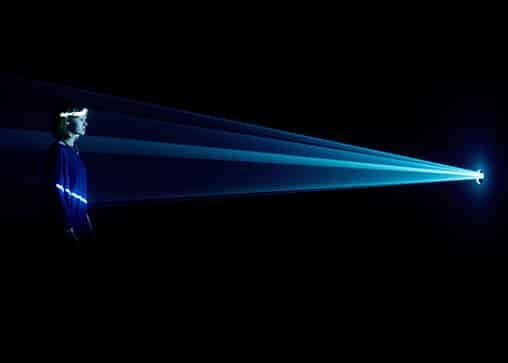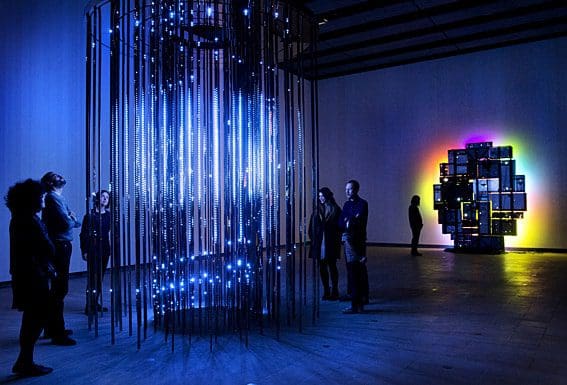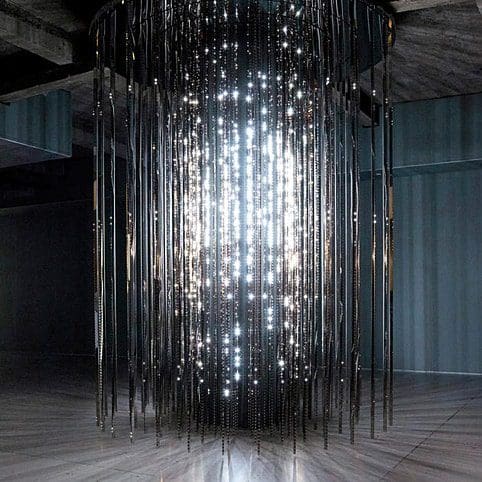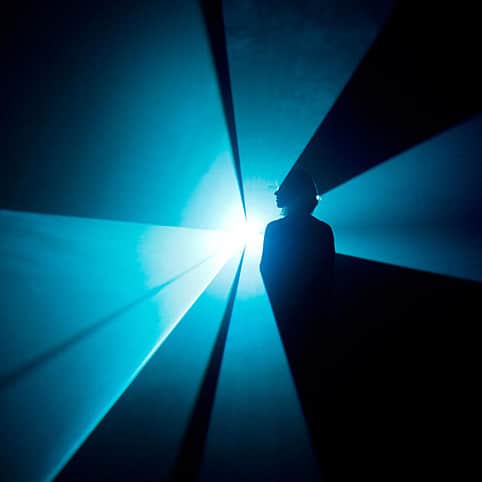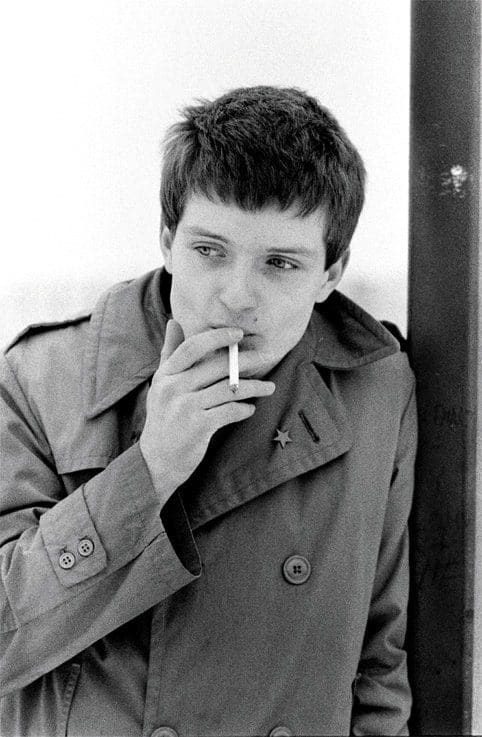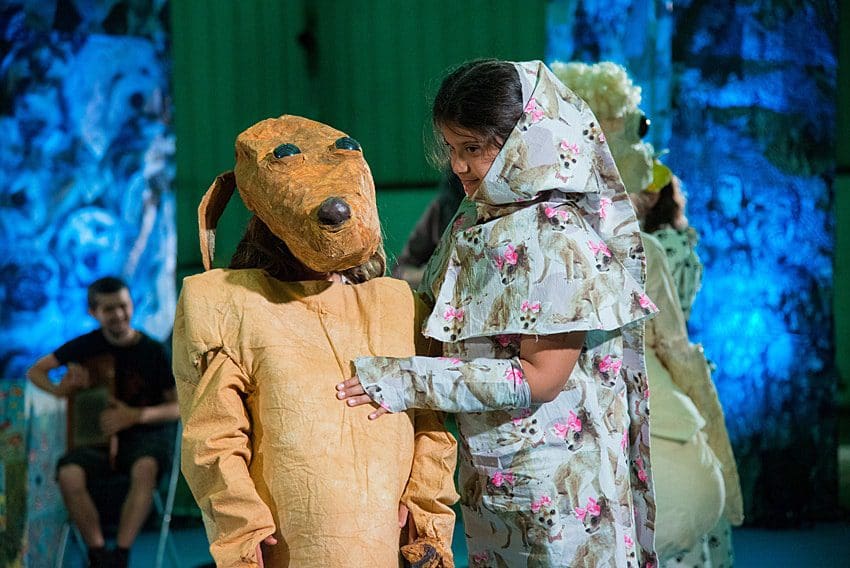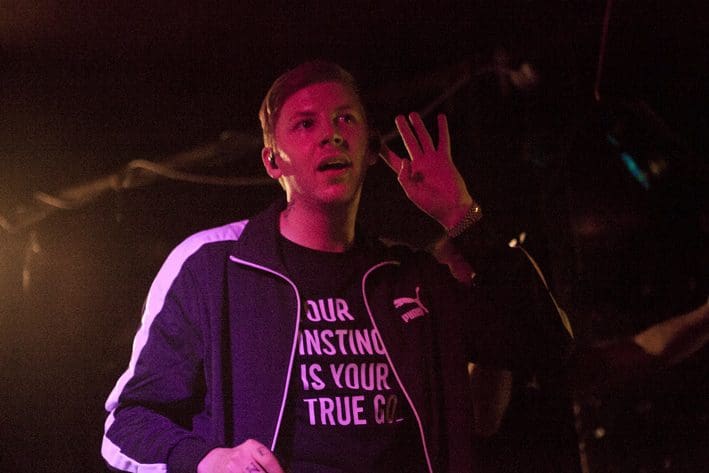The Southbank Centre’s Harmonic Series, now in its third season, continues to excite and intrigue. Not everything works at artist-in-residence Oliver Coates’ attempt to pair pieces by Andrew Hamilton, Alvin Lucier, Morton Feldman (as well as Bach and John Dowland) with light installations at the Hayward Gallery Light Show, but the slightly shambolic nature of the event only adds to the experience.
Some of the shambles belong to me. I was merrily munching a burrito at the nearby, delicious, Wahaca truck with my concert companion at 6:55pm, thinking the concert would begin at 7:30. On hearing it was actually scheduled to start at 7, we panic-ate and rushed upstairs to the Hayward Gallery, only to find out the start time was being pushed back anyway.
Once in, we had a few moments to roam the exhibition before the music started: time enough to admire Leo Villareal’s chandelier centerpiece Cylinder II, made of nearly 20,000 endlessly changing LEDs, and David Batchelor’s Magic Hour, a semiotic stack of lights shunted flush to the wall. Oliver Coates appeared and sheepishly told us that they had lost the CD of the accompaniment for the Alvin Lucier piece and it couldn’t be played until it was found. Andrew Hamilton quickly stepped in and dazzled with The Spirit of Art for violin and voice. The fact that Hamilton performs his own music is to be commended; that he sings as he plays violin is doubly endearing. The music is naïve and enchanting – neoclassical melodic snatches and trills on the violin, as Hamilton sings the equally fragmentary text: ‘The Spirt of Art / I should be listened to / and I’m sorry / The Art is dead / Long live the Art!’ The piece is successfully partnered with Ceal Floyer’s kitschy Throw, a paint-like splat projected onto the floor by a single theatre lamp.
More austere and serious was Morton Feldman’s Voices and Cello, performed upstairs by Oliver Coates and singers Juliet Fraser and Peyee Chen in the unflattering fluorescence of Brigitte Kowanz’s Light Steps, a staircase of tube lighting. Feldman’s gestures change so much in meaning, depending on the environment. The kebab-shop lighting and car-park acoustic here is a world away from the Rothko Chapel, for example, and the music felt harsh and abrasive, rather than meditative and comforting, not least when Coates’ cello spike slips, and is sent skidding, screeching along the concrete floor. Feldman’s music is perfect gallery music, but should accompany normal gallery behavior (freedom of movement, being in charge of your own experience) rather than the impromptu concert etiquette adopted here, where the audience spontaneously sat on the uncomfortable floor to watch in staid reverence. I watched side-on to Kowanz’s lights, but afterwards stood at the foot of the steps, where the musicians had just finished performing, and watched as the parallel lines configured themselves into a kind of monochrome Rainbow Road. Maybe the mood just needed lightening up.
I thought the next piece, again by Andrew Hamilton, would do this. Alas, beyond victory and defeat was even more of an endurance test. A handful of simple chords were scraped from the cello by Oliver Coates, using two bows to play all four strings at the same time, as is currently vogueish. These chords are played over and over, in no particular order, as if Hamilton had magnified the final bars of a Beethoven symphony and inserted a bewildering array of repeat markings. Both these jokes – the Beethoven pastiche, and the frustrating degree of extreme repetition – have been made, better and more successfully, by Erik Satie over a hundred years ago in Embryons Desséchés and Vexations. La Monte Young’s X for Henry Flynt (1960) makes a similar gag too. I’m not sure how well this kind of musical trolling from Hamilton sits with his more earnest, sincere work and the accompanying artwork, Holes of Light by Nancy Holt, is bland and anonymous.
We failed to get into a performance of Bach’s ‘Prelude in D major’ from Suite No. 6 in Ann Veronica Janssen’s tiny Rose room, so took the time to experience the breathtaking Model for a timeless garden by Olafur Eliasson. 27 different fountains gurgle in a room lit by strobe lighting of ever-varying speed. Though unaccompanied by music, it comes close to stealing the show. An artist friend considers Eliasson’s spectaculars masterful, but perhaps slightly vulgar and show-offish too. This may well be the case, but I was certainly sold at the time.
An exercise in restraint followed, with Alvin Lucier’s Wave Songs for female voice with pure wave oscillators finally taking place an hour and a half later than scheduled. The piece was lengthy, always the same, but always changing. Juliet Fraser sang with astounding precision against sine wave drones such that the clashing frequencies created ‘pitch beatings’. The different pulses at times made the whole gallery shake, and at others could be felt only in the canal of the ear, as if the sound was emanating from inside, not out, like John Cage’s famous experience in the anechoic chamber at Harvard. The work navigates minimal and maximal extremes with the sparsest set of gestures, and is the true standout of the programme, above and beyond Olafur Eliasson’s theatrics.
The Lucier piece was essentially the finale of the show with John Dowland’s Flow My Tears (Lachrimae), performed by almost all of tonight’s performers, having the distinct air of an under-rehearsed encore. It was charming nonetheless, taking place under Leo Villareal’s gently blinking lights where the night had began. This gave the evening – an odd series of experimental misfires with moments of genuine sublimity – a surprising circularity. The unintended structure as I experienced it – difficult works bookended by light relief – had also given the concert the narrative shape it didn’t really need. Oliver Coates and his generation of composers, performers and composer-performers such as Andrew Hamilton and Nico Muhly, defy easy categorization and their lack of discipline and haphazard presentation skills make them all the more exciting.
More information from the Hayward Website here
words Thom Hosken


